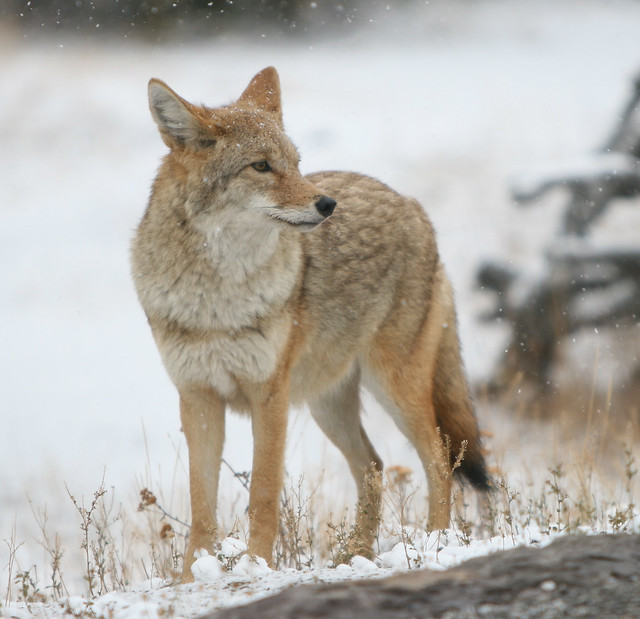
The common coyote is tough to distinguish from its bigger relative. Long the poor stepchild of wild canines, with few friends and even fewer fans, the coyote in northern Minnesota may soon suffer a final indignity: being confused with its bigger, meaner and more charismatic relative, the gray wolf. And being shot dead as a result.
In past deer seasons, Minnesota hunters occasionally have targeted horses and cows thinking they were whitetails, and have even fired upon fellow hunters wearing blaze-orange jackets believing they were deer. So it's inevitable, experts say, that when deer season begins Nov. 3, some of the 3,600 whitetail hunters who also hold lottery-issued wolf permits will shoot coyotes, canis latrans, thinking they are wolves, canis lupus.
"We fully expect it will happen,'' said Department of Natural Resources wildlife program manager Steve Merchant. In this case of mistaken identity, the stakes could be high. Because many hunters who shoot "wolves'' will identify their trophies themselves and register them by phone or online, days or even weeks could pass before pelt inspections required by the DNR show some of the animals to be coyotes.
Meantime, the 200-animal quota set for the first of two wolf seasons offered this fall and winter could be reached and hunting shut down by the DNR, perhaps not to start again regardless of misidentifications. "I have significant concerns about reopening the season under those circumstances,'' Merchant said. "That could get us into a big mess. As soon as we say some number of coyotes were killed by hunters thinking they were wolves, someone is going to say to us, 'Prove they are coyotes.' "And I don't want to get into a position of doing genetic testing on, say, 100 carcasses to do it.''
Misidentifying the two species is understandable. Their social structures are generally the same, and in eastern Canada the two even hybridize. And while adult wolves can out-heft adult coyotes by 60 pounds or more, some wolf pups born last spring will weigh only about 40 pounds in November, the same as adult coyotes, whose prime winter pelts developing just now can make them appear larger than they are. "Trying to identify a wolf pup from an adult coyote is tough under the best conditions,'' said Chris Granrud of International Falls, whose party of five hunts deer near Crane Lake in the heart of the state's northern wolf country.
The group holds two wolf hunting permits. "But it can be nearly impossible if one of the animals is moving quickly by a deer stand,'' Granrud said. Further confusing the issue: Ranges of the two animals in northern Minnesota are increasingly overlapping, despite the wolf's zero tolerance of other canines -- wild or domestic -- invading its hunting grounds.
"Historically, coyotes could be found in northern Minnesota around towns and people,'' said John Hart, a wildlife biologist in Grand Rapids with the U.S. Agriculture Department's Wildlife Services. "Wolves typically have stayed deeper in the woods and wetlands, away from human habitation. "But those ranges have blurred in recent years. Wolves have learned to live closer to people in Minnesota than they did 10 or 20 years ago. I wouldn't say wolves have replaced coyotes in those areas. But they've moved into areas that traditionally were coyote range.''
The differences Relative abundance plays a key role in the way Minnesota wolves and coyotes are hunted. With a statewide population of about 40,000, coyotes can be found in every county, while Minnesota's estimated 3,000 wolves generally are spread across the state's northern tier. The state's first-of-its-kind wolf hunt has been structured, the DNR says, to ensure the animal's population isn't reduced significantly.
Wolf hunters will be allowed a maximum of 200 animals during the season running concurrent with deer hunting, and another 200 in a second hunting and trapping season in December and January. Meanwhile, coyotes can be hunted statewide, year-round, with no limits. They can also be chased by hunters using hounds.
Yet it's the public's attitudes toward the two animals that are most dissimilar. The cartoonish coyote immortalized in popular culture as a crafty but desultory low-life engenders virtually no popular appeal, while the wolf is regarded as a wilderness icon unrivaled except, perhaps, by grizzly bears.
Still, Matt Steffen of Osseo -- like most trappers -- respects coyotes, which seem every bit as smart and wily as wolves. Steffen has a wolf license and will trap near the North Shore. "During deer season you're going to have a lot of rookies with wolf permits who have never seen a coyote or a wolf,'' Steffen said. "They probably figured they'd be deer hunting anyway, and why not put in for a wolf permit? So, yes, they easily could mistake wolf pups and adult coyotes. "But I've seen lots of coyotes in my traps, and I'll know the difference between them and a wolf.''
About reputation:
Since biblical times, the wolf bore a reputation as a marauding villain, from whom neither henhouses nor young girls in red riding hoods were safe. The transformation to today's regal status, renowned Minnesota researcher Dave Mech said, accelerated as the environmental movement blossomed following the first Earth Day in 1970, and after the wolf was placed on the federal Endangered Species List in 1974. "The public glommed onto the wolf,'' Mech said. "And for good reason. It's a very charismatic animal, and domestic dogs evolved from wolves. That's part of the appeal. Wolves even look like dogs.''
But so do coyotes, after a fashion. Yet these unfortunate animals can't seem to catch a break. "Poor, out of luck and friendless'' is how Mark Twain once described them. And now suffering an identity crisis, too.
See video here at source

No comments:
Post a Comment